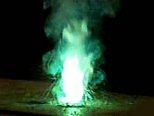 Discovery Information Discovery Information
|
| Who: Sir Humphrey Davy |
| When: 1808 |
| Where: England |
|
 Name Origin Name Origin
|
| Greek: barys (heavy or dense). |
| "Barium" in different languages. |
|
 Sources Sources
|
| Found in barytine (BaSO4) and witherite (BaCO3), never found in pure form due to its high reactivity.
|
| Important mining areas are the UK, Italy, Czech Republic, the USA and Germany. Annual production is around 6 million tons. |
|
 Abundance Abundance
|
| Universe: 0.01 ppm (by weight) |
| Sun: 0.01 ppm (by weight) |
| Carbonaceous meteorite: 2.8 ppm |
| Earth's Crust: 500 ppm |
| Seawater: |
| Atlantic surface: 4.7 x 10-3 ppm
|
| Atlantic deep: 9.3 x 10-3 ppm
|
| Pacific surface: 4.7 x 10-3 ppm
|
| Pacific deep: 2 x 10-2 ppm
|
| Human: |
| 300 ppb by weight |
| 14 ppb by atoms |
|
 Uses Uses
|
| An alloys with nickel is used in sparkplug wire. Barium oxide (BaO) is used in a coating for the electrodes of fluorescent lamps.
|
| Barium sulfate is a good x-ray absorber, used in x-ray diagnostic work for obtaining images of the digestive system (barium meals and barium enemas).
|
| Barium carbonate (BaCO3) is used in glassmaking and also as a rat poison and can be used in making bricks.
|
| Barium nitrate (Ba(NO3)2) and barium chlorate are used to give fireworks green colours.
|
|
 History History
|
| Barium was first identified in 1774 by Karl Scheele and extracted in 1808 by Sir Humphry Davy in England. The oxide was at first called barote, by Guyton de Morveau, which was changed by Antoine Lavoisier to baryta, from which "barium" was derived to describe the metal.
|
|
 Notes Notes
|
| Barium is a metallic element that is chemically similar to calcium, yet is soft and in its pure form is silvery white resembling lead.
|
| Must be stored under a petroleum-based fluid (such as kerosene) to remain pure. |
|
 Hazards Hazards
|
| All water or acid soluble barium compounds are extremely poisonous. At low doses, barium acts as a muscle stimulant, while higher doses affect the nervous system, causing
cardiac irregularities, tremors, weakness, anxiety, dyspnea and paralysis.
|





 Discovery Information
Discovery Information
 Name Origin
Name Origin
 Sources
Sources
 Abundance
Abundance
 Uses
Uses
 History
History
 Notes
Notes
 Hazards
Hazards
 Images
Images


